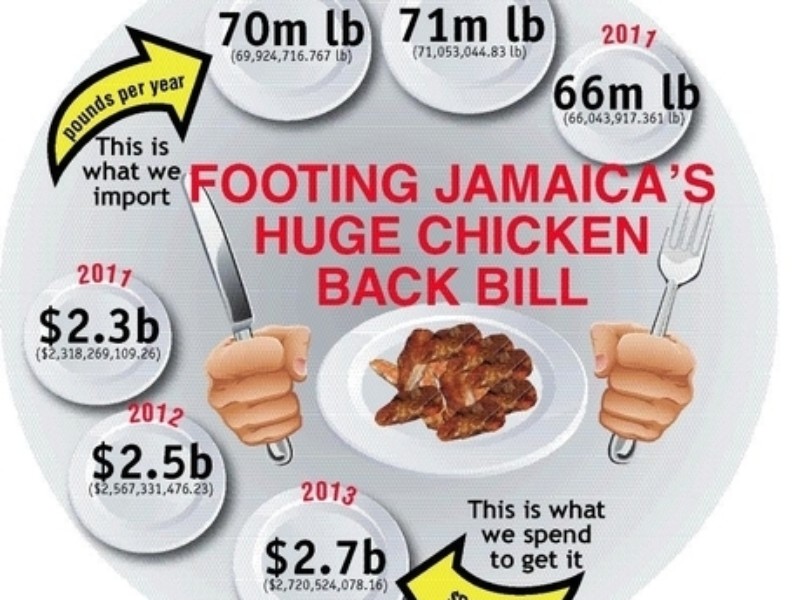
Jamaica Import Record $2.7 billion Of Chicken Back Last Year
Ryon Jones, Staff Reporter
Jamaica spent almost $3 billion dollars last year to import some 70 million pounds of chicken back from the United States, as many Jamaicans continue to depend on this cheap meat for the protein in their diets.
In 2012, $2.5 billion was spent importing chicken back while $2.3 billion was spent in 2011, pushing up the country’s already high import bill despite the 11-year-old Eat Jamaica Campaign.
But officials of Jamaica’s two largest poultry companies believe the import bill will remain high for some time as affordability, not love, push local demand for the chicken back.
Keith Amiel, manager of corporate affairs at the Caribbean Broilers Group, says while his company could produce chicken to meet the demand, the cost would not be attractive to persons who now live on the imported stuff.
“Believing that people like chicken back is a lie, it is not true. They would rather have the mixed parts so that each member of the family can get what they want,” argued Amiel.
“It is not the technical capacity of my company and, I suspect, the other company why we are not producing all the poultry needed to meet local demand, it has to do with the saleability of the chicken at the cost of production of chicken in Jamaica.
“We slaughter on average 80,000 birds per day and about 30 per cent of that is cut up, and once the chicken is cut up then you can separate the back from the rest of the chicken,” added Amiel, as he argued that if a decision is made to stop allowing cheap chicken back into the island, the demand for the meat would be met through local production.
“Within three months of being given the political signal to do It, the two companies would supply all the chicken to replace that,” said Amiel.
“We have the capacity to do it in our hatcheries and we can speed up the rate of grow-out in our current houses to produce more chicken. We also have hatchery capacity; our own hatchery can hatch 600,000 chickens a week, and it could run full all year round if it was needed to run full all year round.
“When I just started out, we imported 60 per cent of all the ham and now we import none, and the same thing can be done with chicken,” he said.
It was a similar argument from Christopher Levy, president and chief executive officer of Jamaica Broilers and managing director of Best Dressed Foods.
“We absolutely can produce in terms of the amount of chicken coming into the island, but not necessarily the chicken back,” Levy told The Sunday Gleaner.
“The argument is that it is poor people food and it is coming in because people can’t afford regular chicken. We don’t have to import and I think the excuse of using it for poor people food is getting a little old. We need to recognise that local production is important and stop importing altogether. This is what has to be on the agenda,” added Levy.
But opposition spokesman on agriculture, J.C. Hutchinson, suggested that a total ban on chicken back importation would not be a simple process.
“It is going to be difficult to cut out the importation of chicken back, because I don’t think that Jamaica Broilers and CB are able to supply the demand for chicken back at this point in time, and that demand is growing,” said Hutchinson.
“It definitely comes in cheaper because most of those in the United States who export, they look at the other parts of the chicken and then they don’t bother with the chicken back, so that is why it is actually what we call leftover.”
Hutchinson said Caribbean Broilers and Jamaica Broilers could not just seek to replace this option with locally produced chicken but should “look at having the chicken back by itself and supplying the market with the chicken back”.
Neck and back
But Levy countered as he pointed out that his company currently sells a lot of neck and back locally, and this will become even cheaper for consumers if the volume produced increases.
“The thing is, the more you produce the cheaper it gets, so it does serve the nation for us to produce it locally. But this is the throw-away part of the chicken for the US, so they let it go way cheaper than the cost of production locally. Our profit margins are certainly depressed, so it’s a challenge,” said Levy.
“We are definitely looking at increasing production, but what really gets you out is when you get a spike in importation of neck and back. It makes better economic sense to increase local production; more employment across the board, more taxes for the Government and greater food security for the country. So there are a lot of benefits to seriously reduce importation of neck and back.”
Amiel further suggested that the major players in the poultry industry do not have to be the ones to supply chicken meat to replace what is being imported. He argued that this earning opportunity could be passed to small farmers.
“Why not put all these youths to work in the country producing their own stuff instead of importing all this?” questioned Amiel.
“And if one government boldly just say it’s done (a discontinuation of chicken meat and back importation), within six weeks it’s done, as we would probably find the number of youngsters growing their own 20 chickens in their backyard would increase dramatically. But somebody has to be bold enough to take the decision.”
source: jamaica observer





















